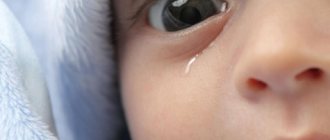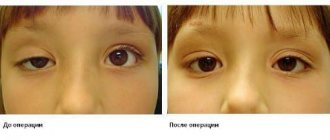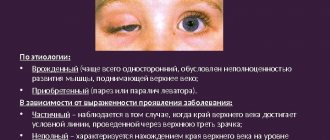Viral conjunctivitis in a child
Viral conjunctivitis in children is quite common.
Such conjunctivitis can be herpetic, enteroviral, adenoviral in nature, or occur as a result of the ingress of other viruses. Viral conjunctivitis in children in the vast majority of cases is combined with colds caused by various viruses. Therefore, viral conjunctivitis is often combined with rhinitis, sore throat, high fever, cough and other symptoms of ARVI. When infected with an adenovirus, a child develops the classic triad of conjunctivitis, pharyngitis and high fever. This manifestation of a viral infection is called adenopharyngoconjunctival fever. Less common is isolated viral conjunctivitis, when only the eyes are affected. A typical isolated viral conjunctivitis is herpetic conjunctivitis. Children most often develop adenoviral or herpetic conjunctivitis.
Any viral conjunctivitis is characterized by the following symptoms:
- Severe lacrimation;
- Redness of the skin of the eyelids;
- Swelling of the skin of the eyelids;
- Conjunctival injection (redness of the eye);
- Scanty mucous discharge, often forming films that are easily removed from the surface of the conjunctiva without leaving damage;
- Numerous gray infiltrates in the mucous membrane of the eye.
With viral conjunctivitis, swelling of the eyelids is less pronounced than with bacterial conjunctivitis. But the redness can be very strong. A characteristic sign of severe viral conjunctivitis is the formation of small blisters on the mucous membrane of the eye in the upper eyelid. Such bubbles are called follicles and indicate deep damage to the mucous membrane, which can spread to other parts of the eye, causing severe complications. Therefore, when follicles appear, you should immediately call a doctor or an ambulance.
Classifications and degrees of myopia full description
How to remove a pinguecula here
Viral conjunctivitis in children appears after acute respiratory viral infections. It is caused by the same virus as the underlying disease. However, recently, the herpes virus has become a common cause of viral inflammation of the conjunctiva. Viral conjunctivitis can be accompanied by bacterial conjunctivitis, so the ophthalmologist must carefully examine the discharge from the baby’s eyes in order to accurately diagnose and prescribe the correct treatment.
In children aged 1 to 6 months, conjunctivitis can be caused by a mucus plug blocking the tear duct. As a result, tears do not perform a protective function, which leads to inflammation of the membrane of the eye. Another common cause of eye inflammation in young children is foreign bodies entering the tear ducts, as well as runny nose and sinusitis. At an early age, the mucous membrane of the eye is affected by external irritants in 15% of cases.
If the disease manifests itself against the background of measles, mumps, rubella or influenza, then the underlying disease is treated - when it passes, the symptoms of conjunctivitis will disappear. The baby’s eyes are washed with a solution of boric acid or herbal infusions (sage, chamomile), sometimes the doctor prescribes a drug called “artificial tears.” It prevents the sclera from drying out and calms inflammation. To treat other types of disease, eye drops and ointments are prescribed.
- Oftalmoferon. In addition to its antiviral effect, the drug increases local immunity and has an antiallergic effect and eliminates itching. Treatment begins with instillation of 1–2 drops. from 6 to 8 times a day. When the child gets better, you can drip less often - 2-3 times a day, until the inflammation goes away.
- Aktipol®. It is used 1-2 drops. 3–8 times a day until signs of the disease completely disappear. After this, treatment is continued for 5-7 days - 2 drops. in each eye three times a day.
- Oftan® Ida (it cannot be used by children under 2 years old). In the first days of therapy, this drug is prescribed 1 drop. every hour during the day and every two hours at night. After improvement, the frequency of instillation is reduced: every two hours during the day, once every four hours during sleep. When the child recovers, the drug is continued for another 3-5 days to prevent the disease from returning.
Before applying the ointment, the baby’s eyes are washed with drinking tea, infusion of sage or chamomile. Then they need to be instilled with Albucid and interferon drops (if the doctor has given permission for their use), and after half an hour the ointment can be applied. Usually the doctor prescribes:
- Florenal. This ointment is active against adenoviruses, herpes simplex viruses and Herpeszoster. It is used 2-3 times a day, the course is from 10 days to one and a half months.
- Tebrofen ointment. Effective for all viral eye infections. For adenoviral conjunctivitis, it is placed behind the edges of the eyelids 3-4 times a day.
- Bonafton®. Effective against some adenoviruses and HSV. For children, it is placed behind the eyelids 1 to 4 times a day and is often combined with 0.05% hydrocortisone ophthalmic ointment (3 to 4 times a day). The duration of the course is approximately two weeks.
Viruses themselves do not respond to antibiotics, but sometimes your doctor may prescribe them to prevent bacterial infections. These can be eye drops with an antibiotic (for example Tobrex®) or ointments - erythromycin or tetracycline. They are placed in the morning and evening; such prevention needs to be continued for 1–2 weeks.
Treatment
Runny nose and conjunctivitis separately do not cause problems in eliminating the pathology, but their joint development requires careful study.
Before prescribing treatment, the doctor finds out the etiology of the disease and prescribes laboratory tests. Based on the results of the examination, the source of the pathology is identified and a treatment method is selected.
The correct selection of drugs will help eliminate the negative effects of harmful bacteria,
Conjunctivitis
There are several types of this disease, each of which has an individual course of treatment.
Viral
In most cases, the viral type of inflammation of the eye mucosa does not require serious treatment; health will be restored in a week. If there is no improvement after 3-4 days, you should contact your local pediatrician for diagnosis and prescribe a course of treatment.
Rinsing with saline solution and the use of warm compresses from decoctions of calendula, string, and chamomile are indicated. If a bacterial infection is detected, the following are applied:
- antiseptic drops;
- Ophthalmoferon is a drug based on interferon;
- Poludan, Actipol, Florenal are agents that prevent the proliferation of viruses.
Bacterial
For bacterial inflammation of the eye mucosa, drugs based on Levomiticin are recommended; Torbex and Albucid help effectively.
It is important to note that if pathology is observed in one eye, both need to be instilled - the child will certainly transfer the infection to the second visual organ when you rub your eyes with your hands, trying to get rid of the unpleasant sensations.
Drops and ointments based on Miramistin are prescribed - the drugs actively fight not only harmful infections, but also have a general strengthening effect on the immune system.
Miramistin simultaneously cures the partner of conjunctivitis - rhinitis.
Allergic
Treatment of allergic conjunctivitis begins after identifying the allergen. If it is possible to remove the source, the disease will quickly pass.
If it is impossible to get rid of the cause, Olopatadine, Ketotifen, broad-spectrum Azelastine, hormonal drops, and antihistamines are prescribed. Cromohexal”, “Lecrolin” eliminate painful manifestations caused by allergens.
If there is a transition to an acute form with a risk of serious complications, antibiotics are used - most often suspensions of Fromilid, Sumamed, Ospamox.
The dosage and timing of administration are prescribed by the doctor; you should not choose treatment methods on your own in order to avoid the negative development of the pathology.
Runny nose
If a runny nose is detected at the very beginning, you can rinse your nose with solutions of sea salt, saline,
Rhinitis is treated with drops, and vasoconstrictor drugs (Otrivin, Nazol Baby) are used for a limited period - no more than 5 days.
Popular products such as Aquamaris and Marimer, which have pronounced antiseptic properties, give good results.
You can help your child with home remedies. If there is an aloe flower in the house, squeezing its leaves will provide effective help. To get rid of snot, it is enough to instill 2 drops into each nostril three times a day.
What it is
Conjunctivitis in general is an inflammation of the mucous membrane of the eyes, which can have a different origin. Its viral form is the most common and is often associated with respiratory tract infections. This pattern is especially clear in children, where there are frequent cases of infection of the mucous membrane during the transfer of biological material from the nose to the eye. This is one of the few forms that can quickly cause a real epidemic if measures are not taken as a team. This form of the disease usually affects both eyes.
In addition to the fact that the disease can be transmitted like a common cold, that is, by airborne droplets, infection also occurs through personal hygiene items, for example, upon contact with a patient’s handkerchief or pillowcase.
Usually the acute phase of this disease lasts up to 10 days, then the disease passes, often without consequences for vision.
This form of conjunctivitis is caused by a viral infection.
Pathogens can be of various types, including this disease can be observed in ARVI.
Currently, there are at least 25 strains of the organism that can provoke such a pathology. However, it often receives pronounced development due to additional contributing factors, including general weakness of the body, disturbances in sleep and wakefulness, and a lack of nutrients in the body. It often occurs against the background of weakening by another infection.
The course of the viral form of conjunctivitis in a child is accompanied by a number of specific symptoms. Among them:
- itching;
- swelling and redness of the mucous membrane;
- photophobia;
- increased fatigue, drowsiness;
- loss of appetite.
As for the discharge that accompanies this type of disease, it can be scanty, usually transparent and does not contain pus. Also, if conjunctivitis is accompanied by another acute infectious disease, the child may also experience an elevated temperature.
The intensity of the symptoms characteristic of the viral form of conjunctivitis directly depends on how active the virus itself is, as well as on the general condition of the child.
Some children may have 2-3 symptoms, while others suffer from all of the above, including fever. Be that as it may, such a condition of the child should cause concern for parents and encourage them to seek help directly from qualified specialists as soon as possible.
Causes
A runny nose and conjunctivitis in a child have different origins.
Viruses
Entering the body through the respiratory system, harmful microbes contribute to the occurrence of the inflammatory process and cause coughing. Traveling further through the body, the viruses enter the nasolacrimal ducts, reaching the eye shell.
Up to 75% of inflammation of the nasopharynx and eyes are a signal of the development of acute respiratory viral infections, influenza, and adenovirus. The diseases are contagious and are transmitted by airborne droplets and contact. There are three forms of viral conjunctivitis:
- adenoviral;
- epidemic;
- herpetic.
Bacterial infection
The problem appears more often at the final stage of treatment for a cold. During the illness, the child’s immunity weakens, which makes it easier for infections to penetrate the defenseless body. Babies often rub their eyes, trying to get rid of the irritating itching, while transferring microbes from the nasopharynx to the mucous membrane of the eyes.
Manifestation of allergies
Responsibility for the occurrence lies with:
- household reasons (dust, mold, household chemicals);
- pets (wool, feathers, food);
- Food;
- flowering plants.
Trying to protect itself from irritating effects, the child’s body produces an allergic reaction in the form of a runny nose, excessive lacrimation, sneezing, and coughing. For children, food products often act as allergens; older children are more susceptible to inhalation - inhaling allergens from the air.
Hypothermia
As a result of prolonged exposure to cold air, the immune system weakens, opening the way for bacteria and viruses. As a result, the formation of a cold or viral disease with all the symptoms, including runny nose, cough and conjunctivitis.
Violation of personal hygiene rules
Mechanical damage of various origins, dirt getting into the eyes from unwashed hands, an attempt to adjust eye lenses with unwashed hands leads to the penetration of infection into the mucous membrane of the eye. Abundant tearing “conducts” microbes into the nasopharynx, from where the bacilli penetrate the nasal mucosa, causing a runny nose.
According to medical statistics, more than 90% of cases of rhinitis and conjunctivitis are a consequence of exposure to bacteria and allergens.
Common pathogens
A feature of the anatomical structure of the nasal cavity is its multichannel communication with nearby organs and systems. The frontal and maxillary sinuses, pharynx, and ocular tear ducts are closely connected. Such proximity makes it easier for infections and viruses to penetrate any of these systems.
The following are considered common to a runny nose of a cold nature and accompanying conjunctivitis:
- infections (enteroviral, adenoviral);
- rhinitis of acute or vasomotor type;
- allergic reaction;
- viral diseases (chickenpox, measles).
Both pathologies - runny nose and conjunctivitis - are closely interrelated. Inflammation of the outer mucous membrane of the eye can form independently, resulting from infection with harmful microbes and allergens. Subsequently, “travelling” through the tear ducts, the bacteria penetrate the nasopharynx, creating a favorable environment for the development of a runny nose.
In another case, the opposite happens: first a runny nose appears, and only then the disease deepens, forming conjunctivitis from a runny nose and its complicated types (sinusitis, sinusitis).
Diagnostics
In order to diagnose a child with the viral form of conjunctivitis, a routine examination by an ophthalmologist is quite sufficient. He must assess the condition of the mucous membrane, interview the child and mother about complaints, measures taken to treat the disease when it was detected, and the child’s daily routine. In addition, it is he who must determine the presence of concomitant diseases, and if they exist, refer the baby to the appropriate specialist. In order to accurately identify the type of pathogen and select adequate drugs for treatment, a scraping of material is taken.
Based on the results of such an examination, the doctor will be able to make a diagnosis and prescribe full treatment to the small patient. It is usually outpatient and does not involve taking heavy medications that require specialist supervision. A repeat visit to the doctor for the child to undergo diagnostics is usually scheduled on the 7th or 10th day after the initial visit.
Usually, with such a diagnosis, the doctor prescribes treatment with local remedies. These are antiviral drops, as well as antiviral ointments, which are placed behind the eyelid. Also, along with such medications, children are often prescribed general strengthening medications so that the body can overcome the disease faster. The child is also prescribed special means for regularly washing the eyes. In the event that there is increased dryness and discomfort, moisturizing drops can also be prescribed, which should preferably be used after washing, so as not to create an environment favorable to infection.
Even if the child gets sick quite often, and the parent himself already knows by heart the drugs used in such cases, the treatment must be selected anew each time. This will allow you to correctly determine the type of pathogen, as well as reduce the risk of viruses mutating and becoming resistant to a particular drug that you usually use.
Complications
Often, even without special treatment, viral conjunctivitis in a child goes away on its own within a few days. But sometimes, with high activity of the virus, as well as very low immunity of the child himself, it can have very unpleasant consequences. One of the main complications in this case is keratitis, damage to the cornea. It causes scar formation. And if the acute diseases occur simultaneously, the risk of corneal damage increases, which even causes areas of clouding.
Remember, unlike conjunctivitis itself, its complications never go away on their own. If you notice them, you should immediately consult a doctor in order to provide your baby with the best level of medical care.
Prevention
It is quite difficult to avoid infection with viral conjunctivitis in children when the child regularly attends school, kindergarten, or other children's group. After all, it only takes one child to become infected with such a disease, and all the others automatically fall into the risk group. However, you can reduce the risk of contracting this disease. For this it is recommended:
- Refuse to attend kindergarten if there are children in the group with an acute form of the disease;
- Teach your child to use only personal hygiene items, and under no circumstances take other people’s scarves or towels;
- Provide your baby with proper nutrition so that he receives the right amount of vitamins and minerals;
- Strengthen immunity;
- Visit the doctor regularly in order to have a complete understanding of the child’s current state of health and be able to take measures, if necessary, to avoid the occurrence of complex diseases.
If you have already noticed the first symptoms of conjunctivitis in your child, he will need to be provided with peace, proper care, and protected from communicating with peers, playing on the computer or watching TV.
And then he will be able to recover as quickly as possible and without damage to his small body.
Although viral conjunctivitis is a rather unpleasant contagious disease, it can be effectively combated. To do this, it is very important to pay due attention to preventing the spread of infection in children's institutions, teach the child to maintain visual hygiene, and also immediately contact specialists at the first signs of illness. And then you can quickly and effectively fight this disease.
Prevention measures
It is difficult to prevent the disease, but careful attention to the child’s health will help to promptly notice the baby’s unhealthy condition. The main thing is to detect conjunctivitis in a child with a runny nose in time and immediately consult a doctor.
The sooner treatment begins, the faster complete recovery will occur. Ignoring the symptoms of conjunctivitis, or believing that everything will “go away on its own” leads to complications that require long-term treatment and constant monitoring by an ENT doctor.
To protect the child from the formation and development of rhinitis in combination with conjunctivitis, parents should take the following measures:
- At a very early age, begin teaching your child basic hygiene rules - wash hands, use only a personal towel and washcloth.
- Consistently and persistently wean off touching your eyes with your fingers.
- Avoid contact with sick children.
- Constantly take care of strengthening the immune system: daily walks, taking the indicated vitamin complex.
- Organize proper nutrition: introduce more vegetables, fruits, dairy products, dietary meat, and fish into the diet.
- fatty, fried foods;
- soda;
- fast food products;
- snacks between main meals.
Prevention will help avoid encountering dangerous infections and preserve the health of the growing body.
How to treat conjunctivitis during ARVI?
The story is as follows: 3 days ago, a 2-year-old daughter fell ill with ARVI in kindergarten (by the way, one boy from the group fell ill a few days earlier, and conjunctivitis was also a complication). Our treatment is standard: drink plenty of fluids, cool, moist air, saline solution in the nose, walks and a minimum of food, if necessary, an antipyretic (the temperature rose to 39.5, it dropped well).
Last night one eye became inflamed, yellow mucus accumulated on the mucous membrane of the eye under the lower eyelid (in my opinion, a lot, the mucus flagellum was quite voluminous and the length of the entire eye). Because This was the first time we encountered such a problem, I couldn’t resist and dropped Levomycetin drops at night - I had them in my home medicine cabinet (1 drop in each eye). When my daughter woke up once at night, her eyelashes were covered in dried mucus, but I still didn’t understand, she couldn’t open her eyes or didn’t want to (while she was crying, her eyes either got wet from tears, opened or didn’t stick together at all). In the morning the same story.
We had an appointment with an ophthalmologist. She said it was a bacterial infection. Directions: Tsipromed drops 1 drop. x 3 rub. per day, Erythromycin ophthalmic ointment 1% - before bedtime, course - a week.
Didn't give me any medicine today. I drip saline solution into my eyes every half hour and remove the nitrous.
Today the snot came out profusely (more than yesterday), opaque and with a slightly yellowish tint.
1. How adequate are the prescriptions of these antibiotics? I read about Tsipromed in E.O.’s reference book. Komarovsky’s “Medicines” that fluoroquinolones are contraindicated for children. Or does this not apply to topical antibiotics?
2. Does this look like viral or bacterial conjunctivitis?
3. How justified did I use Levomycetin drops? Is it possible to continue treatment for them? If possible, then for how long?
4. How often and in what quantities should I drip saline solution?
published 05/30/2015 16:52 updated 03/18/2016 – Pediatric ophthalmology
Answered by Komarovskaya E. A.
The girl has a viral infection, against which the bacterial flora has become more active. Copious purulent discharge from the eyes is an indication for topical use of antibiotics. Treatment begins with chloramphenicol. If after 2-3 days of use there is no effect, the antibiotic is changed. Before instilling antibacterial drops, you must thoroughly wash the purulent discharge (with saline solution, warm water, furatsilin solution) and instill the drops into clean eyes.
Causes and symptoms
- The eyes fester;
- turn red;
- itching intensifies;
- burning;
- every blink causes discomfort;
- blurred vision appears
These are symptoms of sitting too long in front of the monitor, but conjunctivitis can also occur. The mucous membrane, called the conjunctiva, is a thin membrane that extends from the edge of the eyelid along the inside of the eyelid and serves as protection for the eyes.
Conjunctivitis can be of the following types:
- acute purulent;
- lachrymatory;
- accompanied by problems associated with impaired tear production.
The most common causes are viruses and bacteria, that is, an infection that is transmitted through contact. The disease, regardless of the pathogen, is accompanied by excessive formation of viscous secretion (yellowish pus), which sticks the eyelashes together, especially after waking up, creating difficulty opening the eyes.
There is also a risk of this problem as a complication after an acute respiratory viral infection, cold or flu. If disturbances in the visual organs are accompanied by flu-like symptoms (cough, fever, green snot), most likely conjunctivitis is a secondary disease. It can develop both at the beginning of the main pathology and after it.
Colds and inflammation of the conjunctiva - what should you know?
Conjunctivitis associated with diseases such as colds or rhinitis requires more than just local therapy. It is recommended to combine the use of eye drops and nasal spray. It is necessary to receive comprehensive treatment. For these purposes, it is advisable to consult a doctor who, in accordance with the results of the studies, will be able to determine whether conjunctivitis has actually developed against the background of a cold, and will prescribe appropriate therapy.
It should be borne in mind that in the spring the human body is more prone to the effects of viruses (as well as allergic reactions) and, accordingly, the development of the described illness. In summer, people too (children in particular) may be bothered by green snot, cough and fever accompanied by this disease. During this period, the condition is often worsened by sunlight and its reflection from the water.
In the case of a cold accompanied by inflammation of the conjunctiva, it is important to prevent complications of the disease (especially keratitis, which can lead to loss of vision). It is recommended to wear dark glasses and avoid exposure to smoke, dusty environments and smog. People wearing contact lenses should be extremely careful. When the first symptoms of conjunctivitis appear, you must temporarily stop using them.
If any serious health complication occurs or conjunctivitis develops rapidly, it is necessary to visit a doctor who will assess the type, degree and nature of the disease.
Viral pathology
Viral conjunctivitis is the most common type of inflammation of the mucous membrane, the main cause of which (in both adults and children) is the common cold. We are talking about superficial inflammation of an infectious type.
The duration of viral conjunctivitis, as a rule, is from 2 to 3 weeks, the disease is characterized by rapid development during the first week, when the main respiratory disease manifests itself to the maximum. Typical symptoms of the disease are represented by the following conditions:
- serous secretion (the affected eye may fester);
- feeling of a foreign object in the eyes;
- pain;
- hyperemia;
- subconjunctival hemorrhage;
- swelling of the eyelids;
- photophobia;
- follicular reaction;
- preauricular lymphadenopathy.
Follicles are multiple, round, yellow. They represent hyperplasia of lymphoid tissue and, unlike the papillary reaction, do not have a vascular pattern.
In addition to the viral type of the disease, this symptom is also present in chlamydial inflammation and toxic reactions. If conjunctivitis occurs from a runny nose, the disease is accompanied by nasal discharge, cough, fever, weakness and other symptoms that often occur with colds and flu.
Description of the adenoviral form of pathology
Conjunctivitis caused by adenoviruses is the most common inflammation of the mucous membrane that occurs during ARVI. The adenoviral type of the disease occurs under the clinical picture of epidemic keratoconjunctivitis or pharyngoconjunctival fever. This is a very contagious viral type of pathology that is easily transmitted.
Epidemic keratoconjunctivitis most often occurs in adults. Typical for it is the rapid development of symptoms characteristic of both a cold and eye inflammation (weakness, cough, runny nose, pain, red and purulent eyes).
Pharyngoconjunctival fever is typical for children accompanied by current upper respiratory tract disease. In addition to the manifestation of inflammation of the conjunctiva, there is a runny nose, a cough in the child, and sometimes a sore throat. This infection is characterized by a rapid onset, clear signs of viral conjunctivitis, elevated temperature and a duration of 2-3 weeks.
Treatment of the adenoviral type of disease is only symptomatic. Cold compresses, vasoconstrictor drugs are recommended, and in cases of bacterial superinfection, an antibiotic therapeutic course.
Steroids may have a positive effect on corneal infiltration, but have no effect on disease duration. Treatment must be accompanied by strict hygiene requirements due to the high risk of infection transmission.
What are the dangers of conjunctivitis and runny nose for a child?
The runny nose and conjunctivitis themselves are not dangerous diseases, but in the absence of timely treatment they can provoke other diseases or become chronic. , blepharitis, keratitis, iridocyclitis, sinusitis, sinusitis and other diseases can develop Quite often, against the background of rhinitis, inflammation of the pharyngeal mucosa occurs, lymphoid tissue is damaged, which causes symptoms of pharyngitis and conjunctivitis , and the upper respiratory tract may be affected.
Treatment of pathology at home
Mild conjunctivitis can be treated at home, but if the disease does not subside within 3-4 days after the cold, consult a doctor:
- Use chilled boron water for rinsing.
- If this is not enough, use Ophthalmo-Septonex drops (over-the-counter drug) or their equivalents. Gently push back the lower eyelid, looking towards the nose with your eye. Inject 1 drop into the outer corner. Treat each eye separately. If only one eye is affected, start with the healthy one. Leave your eyes closed for a few seconds after applying the drops. In case of significant difficulties, administer the drug every 1-2 hours, after the symptoms have subsided - 2-3 times a day.
- Do not use contact lenses, avoid makeup.
- Never touch inflamed eyes with your hands. Friction increases the risk of transmitting infection from one eye to the other.
- If you feel dry, avoid exposure to air conditioning or strong winds (these conditions further dry out your eyes) and second-hand smoke (irritation).
- Do not strain your eyes by watching TV or working on the computer for a long time.
- Protect your eyesight with dark glasses.
- The infectious form of inflammation requires increased compliance with hygiene rules.
- In case of persistent negative process or bacterial infection, treatment should include eye drops or antibiotic ointment.
- Protect your eyes from excessive light.
Prevention
Prevention of conjunctivitis, as well as rhinitis, in children consists of following certain rules, which will help significantly reduce the risk of developing these diseases.
- Monitor the child's hygiene.
- Do not touch your eyes with dirty hands.
- Before eating or coming home from outside, wash your hands with soap.
- Regularly boost your immunity.
- Spend as much time as possible outdoors.
- Avoid contact with sick people.
- Eat right, follow a daily routine.
Compliance with simple rules will not 100% protect a child from various viral or bacterial diseases, but at the same time it will significantly reduce their development and ease the course of the disease.
Source
The influence of air conditioning on the development of the disease
Summer rhinitis is the most common cold symptom. If you are in a car or at home with the air temperature set to 20ºC, and then go outside where the air is hot in the summer sun, do not be surprised that you will soon feel a burning sensation in your nose, swelling of the mucous membranes and the appearance of a cold.
With a decrease in immunity and heat shock, viruses have a chance to remain for a long period on the dry mucous membrane of the nose and spread further, causing, for example, inflammation in the organs of vision.
Conjunctivitis is one of the most common conditions for which people visit the eye doctor's office. Dry inflammation of the conjunctiva is the cause of dry eye syndrome. We are talking about a disorder of moistening the sensitive surface of the eye with tears (a healthy person continuously produces a tear film).
The clinical picture can be represented by such signs as:
- redness;
- discharge;
- a feeling of slight pressure, sand, or a foreign body in the eye;
- Pain in the eyes.
The cause is usually exposure to air conditioning, fans and dry air. How to cool properly? The following must be taken into account:
- the difference between the internal and external temperatures should be a maximum of +5…+7ºC;
- if possible, try not to frequently alternate transitions from cold to warm, and vice versa;
- install the air conditioner so that the cold air is not directed at you;
- While staying in an air-conditioned environment, drink enough fluids - warm drinks are ideal (the air conditioner dries the air and, accordingly, the mucous membranes).
Prevention of respiratory tract infections and colds
Respiratory infections are a relatively common cause of inflammation of the conjunctiva in children of infant, preschool, school age and adults. The basis for preventing colds is considered to be hardening, sports, being in the fresh air, in the mountains or by the sea, adequate sleep and a healthy, balanced diet rich in vitamins and microelements (there are many of them in their natural form in fruits and vegetables).
Excessive stress, both physical and mental, has the opposite effect. Prolonged stress weakens the body and increases its susceptibility to infections. In addition, it has a negative impact on the growth of children.
To prevent frequent diseases, immunomodulatory drugs or systemic enzyme therapy and properly selected homeopathic treatment play an important role. Immunomodulators are substances that simulate the situation of a collision with a pathogen in the body and ensure the development of its defense. The immune system strengthens and becomes better able to cope with pathogens - viruses and bacteria.
Systemic enzyme therapy (drugs that combine suitably formulated enzymes) helps strengthen the functions of the immune system. Such treatment can reduce the frequency of respiratory infections, ease their course and the occurrence of complications, including conjunctivitis.
At the first signs of inflammation of the conjunctiva, you should begin to take therapeutic measures. This will help prevent complications that can lead to vision loss.
It is advisable to consult a specialist who will determine the causative agent of the disease. This is important for determining the therapeutic approach and excluding complications of conjunctivitis: in the case of viruses, antibiotic treatment will not be effective, unlike a bacterial pathogen.
In addition, symptomatic treatment of a common disease - the common cold - is also important. It includes taking analgesics (painkillers) and antipyretics. Bed rest and adequate sleep play an important role. It is during sleep that the body regenerates and copes better with the disease.
Treatment methods
Treatment of conjunctivitis and rhinitis in children is carried out as prescribed by a doctor and only after the underlying cause has been established. In order to determine the nature of the disease, the doctor prescribes a series of laboratory tests, the results of which will help determine the pathogen and prescribe appropriate treatment therapy.
Antimicrobial drug Sumamed
Treatment of conjunctivitis and runny nose in children is carried out comprehensively, using drugs for local and internal use . The acute course of the disease often requires the use of antibiotics, but such medications are prescribed only when the disease is viral or bacterial in nature, when severe symptoms are present, body temperature rises, or there is a risk of all sorts of complications. Basically, doctors prescribe broad-spectrum antibiotics: Sumamed, Augmentin, Ospamox, Fromilid and others, which are available in the form of a suspension for children. The dose of any antibacterial drug, as well as the duration of its use, is prescribed by the doctor individually for each patient.
An integral part of medical therapy is the use of drops for the eyes and nose . For severe runny nose and congestion, the doctor prescribes vasoconstrictor drugs: Otrivin, Nazivin, Nazol and others. You can use these nasal drops for no more than 5 days.
Oftalmoferon eye drops
Eye drops are used to treat conjunctivitis . So, for the bacterial form of the disease, doctors most often prescribe Tobrex, Albucid, Oftaquix . For viral infections - Florenal, Oftalmoferon, Poludan, Actipol , and for allergic ones - Lecrolin, Cromohexal, Vibrocil and others. The course of treatment and dose are determined by the doctor.
Washing is considered important in the treatment of inflammatory processes in the mucous membranes of the nose and eyes . As an eye wash for conjunctivitis, you can take herbal decoctions: chamomile, calendula, string . Children over 2 years old can use Furacilin solution or 2% boric acid . It is recommended to wash your eyes 3-4 times a day.
Isotonic saline solution Marimer
To care for the nasal cavity, it is recommended to use saline or isotonic solutions: Aquamaris, Marimer, Humer and others, which are excellent antiseptics for combating various pathogenic pathogens.
For frequent colds or conjunctivitis, the doctor will advise parents to pay attention to the state of the child’s immune system and may prescribe vitamin complexes or immunostimulants.
General clinical picture
Typically, viral conjunctivitis in children manifests itself against the background of an acute respiratory viral infection. But conjunctivitis caused by the herpes virus is increasingly being diagnosed. Sometimes a bacterial infection is observed, so before treating a child, the doctor must carefully examine the discharge from the eyes.
In addition, the child develops the disease due to the presence of:
- foreign body in the lacrimal ducts;
- runny nose;
- sinusitis.
The influence of many external stimuli should not be excluded.
From the moment of infection until the first symptoms in a child become obvious, it can take from 4 to 12 days. Most often, the pathogen enters the body through contact from a sick child to a healthy one. Airborne transmission is much less common.
Naturally, the existing characteristic symptoms will indicate that the child has conjunctivitis.
You should know that regardless of the etiology, a viral disease, in most cases, manifests itself with similar symptoms:
- The conjunctiva is affected by follicles.
- Redness, lacrimation, itching are the result of the fact that the eye vessels enlarge and the nerve endings are irritated.
- Initially, one eye is affected, but rather quickly the infection spreads to the other.
- There is an increase in the pre-auricular lymph nodes. If you touch them, the patient will feel pain.
- Sometimes the baby suffers from photophobia. He may also feel as if something foreign is in his eye.
- When the transparency of the cornea deteriorates, that is, it becomes cloudy, visual functions may be weakened. This condition often persists for 2 years after treatment has been completed.
Conjunctivitis of adenoviral and herpetic nature
If we talk about infection that is transmitted precisely by airborne droplets, then we are talking about adenoviral disease. In this case, the inflammatory process develops in the eye area and in the nasopharynx.
Symptoms of this type of conjunctivitis are as follows:
- In a child, the disease occurs simultaneously in the presence of acute respiratory viral infections, high temperatures, and enlarged lymph nodes.
- The condition is accompanied by redness of the eyes and eyelids, swelling, scanty discharge without pus.
- There is a negative reaction to light, tearfulness.
- If the form of the disease is follicular, then there are follicles or films.
- Only rarely is corneal damage observed.
When the herpes virus becomes active, it affects the skin and mucous membranes. The conjunctiva of the eyes often falls under its influence.
Then you can observe the corresponding symptoms:
- Typically, the inflammatory process is observed only on one of the organs of vision.
- The course of the disease is slow. Symptoms are mild.
- The eyelids and skin surface near the eyes become covered with a characteristic rash. The child suffers from photophobia, itching and lacrimation.
- The catarrhal form is characterized by the presence of mucous secretions in small quantities. When a bacterial infection is added, the discharge becomes purulent, so not only antiviral but also antimicrobial treatment will be needed.
- The follicular appearance is accompanied by the formation of follicles on the mucous membrane. Intensification of the inflammatory process leads to the occurrence of ulcers and erosions.
- The development of dendritic keratitis, which affects the cornea, cannot be ruled out.











